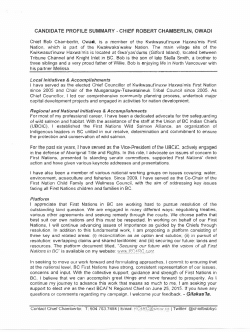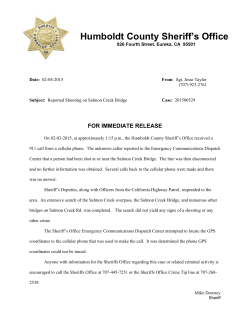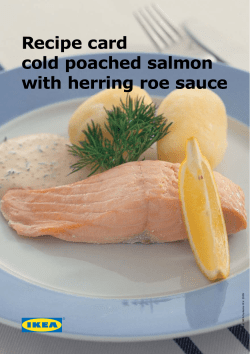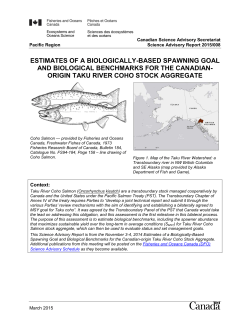
Lent 5 () - Christ Episcopal Church
Sermon for Lent 5, March 22, 2015 ~ Elena Vera “To dust we shall return.” That’s not a joyful image, for most of us. If you’ll indulge me, I’d like to reframe it with another story about returning, and ending, and about going, ultimately, in this Lenten season, to where we know, deep down, we need to go. Environmental writer David Suzuki wrote a really wonderful essay about the way that the Pacific salmon run feeds all of the famous old-growth forests of impossible, towering redwoods, up and down this coast. You might or might not know this: but they’re born in fresh water, up rivers throughout this region, and head immediately out to live most of their lives in the sea, to eat and grow and experience, until, one day, something in them wakes up, and they are compelled to return to the very river that spawned them, to swim up it to the same place where their lives began, to spawn their own eggs and there, having spent all their strength in the journey, to die. Suzuki writes about the way those salmon dredge up literal tons of life, with their bodies, out of the depths of the ocean, and bring that upstream to feed hundreds and hundreds of miles of watershed, land that has never seen a seabird but thrives because of the loving sacrifice of spawning salmon. This is a story about death. We avoid those sorts of stories, most of the time, especially when there are children in the room. We use euphemisms and sidesteps or treat that enormous, every-year mass death as an unfortunate consequence of the way things work, instead of a precious part of the churning of the living world. The salmon don’t avoid it. A salmon won’t let anything stop it on the way to its death. A salmon has lived, and knows now, somehow, to come home, and will fight currents, rapids, grizzly bears, concrete dams, leaping up waterfalls with a lifetime’s stored-up might to go where it must go to die. And thank goodness! Nothing lives in this part of the world I love, not so richly or recognizably, without the thick thousands of dying salmon, their deaths feeding every life here even a 1 hundred feet up in the treetops, lives no salmon could ever see, touch, or comprehend, lives whose own deaths carry on feeding other lives. People who live close to what feeds them aren’t so surprised by this, that death is necessary for everything to live. Farmers, ranchers, hunters, fisherfolk, they all live up close to the reality that the death of a weed or an insect makes it possible for the crop to grow, and the death of plants feeds livestock, or humans; that the death of the fish feeds the seal, the bear, the osprey, and its decay feeds the decomposers, the crawling things, the tall trees and the mushrooms. Any backyard garden will teach you that death feeds the land, as last year’s tomato plant is mulched under to enrich next year’s soil, as pruning dead branches helps the green ones to thrive, as no rosebush flourishes without the killing of some aphids. Most of us, though, in our industrialized society, in what we call late-stage capitalism, don’t live near the source of our food—or the sources of the minerals, metals, plastic, wood and stone out of which we make the things we use and the homes we live in. We don’t see where they come from, how much is there, how is left, who labors to bring them to us. Much of our food comes from enormous factory farm operations whose daily practices would trouble us if we had to see them all the time up close, in their treatment of soil, watershed, animals, and, all too often, brutally exploited human workers who are our neighbors. Our culture strongly encourages us not to look, and our economy tries to keep us as separate as possible from the lives of those workers and the land they labor on in order to maximize profit. This is not coincidental: it’s part of a pattern. We hide the deaths on which our lives are built as part of hiding death generally. We hide our garbage, even shipping it to other countries across the sea; we hide the junk and flotsam of our old cars and tanker ships. We hide our human waste and where it goes. We hide, and hide from, our own dying bodies. Amidst a thousand products that promise anti-aging and immortality, we hide away our sick, our illness and weakness. We keep people with disabilities out 2 of public view, and isolate our aging to the point of too often making them die alone, just to avoid the reminder of what’s coming for us. Then we hide the fact of their death, avoid talking to children about it, assign three days bereavement leave from work and buck up and get past it. And then we fill the bodies of the dead with preservatives, sealed in concrete vaults, so they cannot decay and return their substance to the soil, often poisoning the groundwater in the process just to preserve the illusion that nothing ends. Our culture is terrified of mortality. It’s not coincidental—our pathological avoidance of the inevitability of death is a fundamental engine of the runaway economic and cultural system we live in. It promises endless growth, bottomless consumption, with no death, a world where we can waste our lives accumulating wealth and objects because we can pretend they have no real cost, and we get to keep them, for eternity. Late-stage capitalism—what writer Joanna Macy calls the “Industrial Growth” ideology—depends on the denial of death as a fact in our lives. It feeds our fear of death as the worst possible thing and exploits it, to keep us from looking at the consequences of our way of life and to sell us the story that it can go on forever, without limits, without accountability to any greater family of life, teaching us that we’re outside the system of nature and in control of it, top to bottom. This is not a death-seeking culture, but a culture that idealizes one kind of life: tumorous, unchecked growth, where we can take and take and never have to give any of it back. It relies on our fear of death to keep us from looking behind the curtain at what we have made much worse than death: empty acid seas, a burning sky, fertile valleys becoming cracked desert, whole lives spent on trash heaps, a landscape groaning for mercy. The thing is, death means limits. Death means this train stops, eventually, each of our lives stops, that our culture, our species, even our planet have an ending. It’s a rule to which we are all accountable, rich and poor, good and bad, and there’s no buying your way out of it, no running from it, no deserving or not deserving it. In a essay recently reprinted in the Utne Reader, Alaska writer Eve Saulitis calls Death 3 “the wildest thing of all, the least tamed or known phenomenon our consciousness has to reckon with,” a reminder that “nature is willful…[and] we have no dominion over the wild darkness that surrounds us.” It’s the last wild thing we cannot touch or master, the proof that we do not control everything, that we are of nature, of this great interconnected system, part of it, beholden to it, of its common body. That humbling fact is anathema to the destructive ideology that insists that we own everything, and are outside what happens to it. Reckoning with death shatters our illusion of control, and our illusion that this world belongs to us rather than us to it. Every cell in our bodies came to us in trust from another living thing, and our flesh is temporary. These are borrowed bodies on borrowed time, and death says that an unavoidable day comes where we have to give all of it back, pass it on to the next tenant. It’s held in trust, for those who come after us. The fact of death means this life is precious, bounded, finite, that our lives are bound together and continuous with each other. In this borrowed soil of our flesh, death is a seed planted and growing quietly, until the day it must blossom. But our cultural refusal to look death in the face keeps us too scared to face not only our own mortality but the mortality of the greater interconnected web of life to which we belong. Everything dies, without exception: microbes and mammoths, gardeners and galaxies, and in this scale from planet to paramecium, our earth’s lifespan may be longer than ours, but it is a life, swimming steadily upstream toward its ending. It has limits, too. And our fear keeps us from seeing how far we’ve tested those limits, how bad this ecological crisis has gotten, and keeps us from dealing with it. We have made endless distractions from the seriousness of the situation, and invented ideologies that tell us that no matter how bad it gets, the virtuous few will be whisked away from the consequences before they hit—made exempt from interdependence and 4 suffering by the Rapture, by the Singularity, by healthy living and daily yoga and juice cleanses. In our fear we treat death as an enemy to fight, even though it can’t be beaten, which makes all of our lives look like losing. How can we embrace a joyful life while fighting endlessly with the one thing in life we know for a certainty? Our fear keeps us from facing up to the hopeful challenge of changing the destructive way we live with resolve instead of anxiety. We have a culture that pretends that a cow doesn’t have to die for my roast beef sandwich, where we are encouraged to hide away the deaths of loved ones in sterile places far from home. How are we supposed to cope with the millions-strong death tolls of climate change already in process across the globe, in famine and hurricane and wars of scarcity? How are we supposed to mourn the death of life as we know it when we’re trained at every turn to see that as defeat, rather than the only way to “life as we don’t know it yet”? The situation we find ourselves in, make no mistake, is bad. To face it, we need to be resilient and courageous, to face up to the hard work of turning this cancerous society of endless, un-accountable expansion around. I think one place we have to start is finding a way back to facing—and indeed—loving death, as we are given the opportunity to do in this season every year. Death makes life possible and meaningful, not just in sustenance and story, but in evolution—it is the process where some creatures die first while others adapt and die later, reproducing, growing, selecting to which we owe the extraordinary and exquisite diversity of our world. The compost of each generation makes our living world fresh and ever-changing. More than that, though, universal mortality isn’t just some iron-fisted threat: it’s a community to which we all belong, every thing, from the death of a moment to the death of a cosmos. In this unpredictable, often frighteningly chaotic world, full 5 of deep inequities and divides, death is steady, reliable, true, a promise always kept, a pointer to the other things in this universe that we can hope are constant. Death is a universal congregation tying us to all things in a common experience that can’t be avoided. In death, everyone and everything is welcome, unconditionally, no one not good enough, no one not wanted, no one turned away at the door for lack of funds, a model we could do well to emulate. There’s no need to rush toward it; it will find its reliable way to each of us in time, and that truth can help us relish every moment that we have to breathe together. Death is a kinship we can pretend away but cannot revoke. And in this moment, in this time, we need every kinship we can find. None of us is alone in this. We all go out swimming into the deep blue world, gathering up a long or short lifetime’s worth of experiences, feeding our borrowed bodies with the substance of other living things. And then the day comes where we find our way back to the streambed where we started, and if we can embrace it, we swim strong carrying everything we have been, until we get this final gift: we get to give it all back. Death is not losing a fight. It’s bringing back what we borrowed and letting it be something new, with new meaning. We don’t choose that act of sharing, but we do choose what we share: do we, with our lives and deaths, thank the world for what it gave us by leaving it well-fed and blooming, or do we clutch fearfully to every last piece of ourselves, to every illusion of separation from each other, and poison the whole watershed for generations to come? Because we will, without exception, be asked to give it all back, in one condition or another. We give our bodies back to the world, to break down and feed other bodies. We give our experiences back to those around us, sharing out our personalities and understanding in the way we teach and joke and embrace and fight and hope. 6 And, whatever we believe of an immortal soul, we share out who we have been, ultimately, in the memories of everyone we touched, and everyone they touch, echoing out into forever. We die, in the rushing stream that calls each of us home, and we share, at last, all that we ever were to feed the towering forest of lives beyond our imagining, in a soaring song of mortality that joins us with all that ever will be. And like the dauntless silver salmon, we are enough, if we just turn upstream and get there together. 7
© Copyright 2025
















